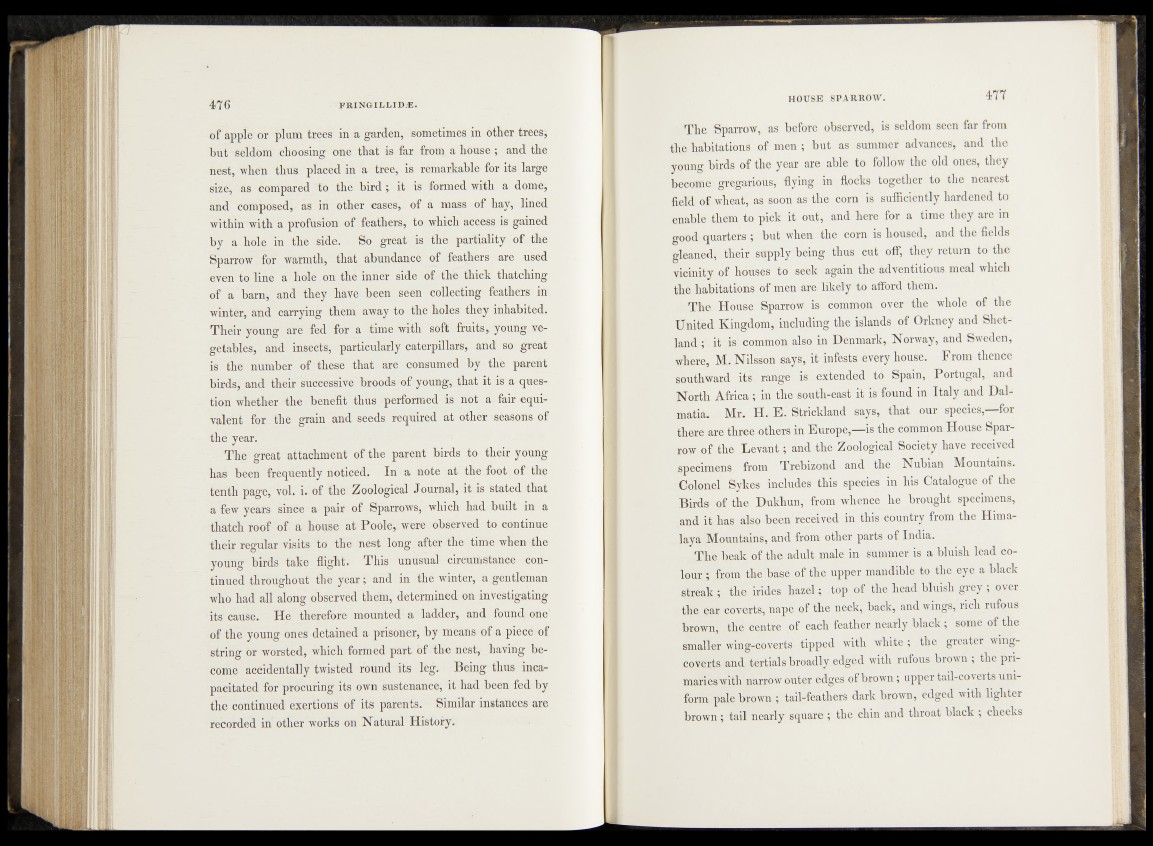
of apple or plum trees in a garden, sometimes in other trees,
but seldom choosing one that is far from a house ; and the
nest, when thus placed in a tree, is remarkable for its large
size, as compared to the bird ; it is formed with a dome,
and composed, as in other cases, of a mass of hay, lined
within with a profusion of feathers, to which access is gained
by a hole in the side. So great is the partiality of the
Sparrow for warmth, that abundance of feathers are used
even to line a hole on the inner side of the thick thatching
of a barn, and they have been seen collecting feathers in
winter, and carrying them away to the holes they inhabited.
Their young are fed for a time with soft fruits, young vegetables,
and insects, particularly caterpillars, and so great
is the number of these that are consumed by the parent
birds, and their successive broods of young, that it is a question
whether the benefit thus performed is not a fair equivalent
for the grain and seeds required at other seasons of
the year.
The great attachment of the parent birds to their young
has been frequently noticed. In a note at the foot of the
tenth page, vol. i. of the Zoological Journal, it is stated that
a few years since a pair of Sparrows, which had built in a
thatch roof of a house at Poole, were observed to continue
their regular visits to the nest long after the time when the
young birds take flight. This unusual circumstance continued
throughout the year; and in the winter, a gentleman
who had all along observed them, determined on investigating
its cause. He therefore mounted a ladder, and found one
of the young ones detained a prisoner, by means of a piece of
string or worsted, which formed part of the nest, having become
accidentally twisted round its leg. Being thus incapacitated
for procuring its own sustenance, it had been fed by
the continued exertions of its parents. Similar instances are
recorded in other works on Natural History.
The Sparrow, as before observed, is seldom seen far from
the habitations of men ; but as summer advances, and the
young birds of the year are able to follow the old ones, they
become gregarious, flying in flocks together to the nearest
field of wheat, as soon as the com is sufficiently hardened to
enable them to pick it out, and here for a time they are in
good quarters ; but when the corn is housed, and the fields
gleaned, their supply being thus cut off, they return to the
vicinity of houses to seek again the adventitious meal which
the habitations of men are likely to afford them.
The House Sparrow is common over the whole of the
United Kingdom, including the islands of Orkney and Shetland
; it is common also in Denmark, Norway, and Sweden,
where, M. Nilsson says, it infests every house. From thence
southward its range is extended to Spain, Portugal, and
North Africa; in the south-east it is found in Italy and Dalmatia.
Mr. H. E. Strickland says, that our species,— for
there are three others in Europe,—is the common House Sparrow
of the Levant; and the Zoological Society have received
specimens from Trebizond and the Nubian M^ountains.
Colonel Sykes includes this species in his Catalogue of the
Birds of the Dukhun, from whence he brought specimens,
and it has also been received in this country from the Himalaya
Mountains, and from other parts of India.
The beak of the adult male in summer is a bluish lead colour
; from the base of the upper mandible to the eye a black
streak ; the irides hazel; top of the head bluish grey ; over
the ear coverts, nape of the neck, back, and wings, rich rufous
brown, the centre of each feather nearly black ; some of the
smaller wing-coverts tipped with white ; the greater wing-
coverts and tertials broadly edged with rufous brown ; the primaries
with narrow outer edges of brown; upper tail-coverts uniform
pale brown ; tail-feathers dark brown, edged with lighter
brown; tail nearly square ; the chin and throat black ; cheeks